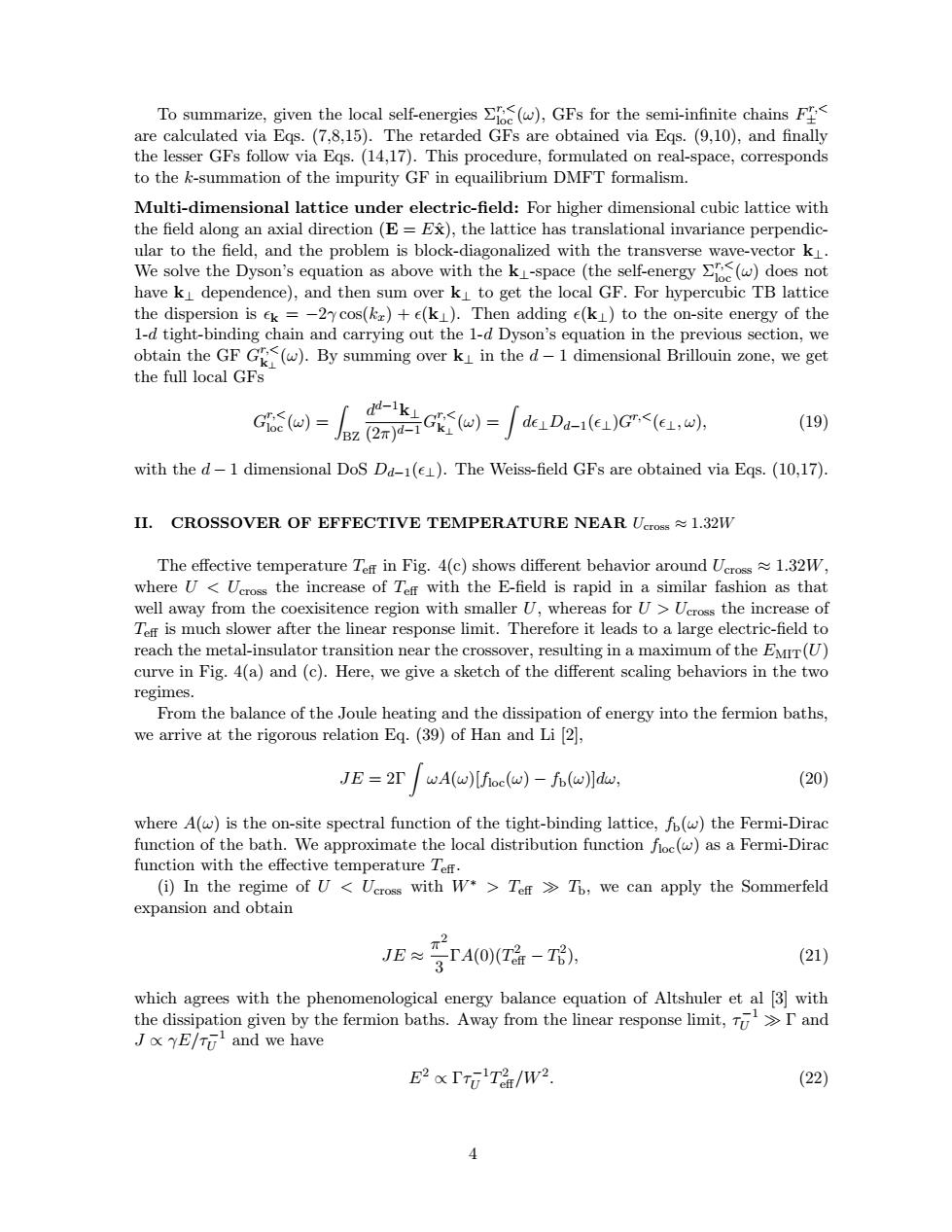正在加载图片...

To summarize,given the local self-energies o(w),GFs for the semi-infinite chains F are calculated via Eqs.(7,8,15).The retarded GFs are obtained via Eqs.(9,10),and finally the lesser GFs follow via Eqs.(14,17).This procedure,formulated on real-space,corresponds to the k-summation of the impurity GF in equailibrium DMFT formalism. Multi-dimensional lattice under electric-field:For higher dimensional cubic lattice with the field along an axial direction(E=E&),the lattice has translational invariance perpendic- ular to the field,and the problem is block-diagonalized with the transverse wave-vector k We solve the Dyson's equation as above with the k-space (the self-energy o(w)does not have k dependence),and then sum over k to get the local GF.For hypercubic TB lattice the dispersion is ek =-2ycos()+e(k).Then adding e(k)to the on-site energy of the 1-d tight-binding chain and carrying out the 1-d Dyson's equation in the previous section,we obtain the GF Gs(w).By summing over k in the d-1 dimensional Brillouin zone,we get the full local GFs r dd-1k ()=()=deD-(e)G() (19) with the d-1 dimensional DoS Da-1(eL).The Weiss-field GFs are obtained via Eqs.(10,17). II.CROSSOVER OF EFFECTIVE TEMPERATURE NEAR U1.32w The effective temperature Te in Fig.4(c)shows different behavior around Ueross1.32W. where UU the increase of Ter with the E-field is rapid in a similar fashion as that well away from the coexisitence region with smaller U,whereas for U>Ueross the increase of Te is much slower after the linear response limit.Therefore it leads to a large electric-field to reach the metal-insulator transition near the crossover,resulting in a maximum of the EMrr(U) curve in Fig.4(a)and(c).Here,we give a sketch of the different scaling behaviors in the two regimes. From the balance of the Joule heating and the dissipation of energy into the fermion baths, we arrive at the rigorous relation Eq.(39)of Han and Li [2], JE=2rwA(w)[floc(w)-fo(w)]dw, (20) where A(w)is is the ith the effecti (i)In the gime of U Ucroes with W>T To:we can apply the Sommerfeld (21) es with the phenor uation of Altshuler et al [3l with on given by the fermion baths.Aw which ag the dissin response limit,and E2xT Te/W2. (22) 4 To summarize, given the local self-energies Σr,< loc (ω), GFs for the semi-infinite chains F r,< ± are calculated via Eqs. (7,8,15). The retarded GFs are obtained via Eqs. (9,10), and finally the lesser GFs follow via Eqs. (14,17). This procedure, formulated on real-space, corresponds to the k-summation of the impurity GF in equailibrium DMFT formalism. Multi-dimensional lattice under electric-field: For higher dimensional cubic lattice with the field along an axial direction (E = Exˆ), the lattice has translational invariance perpendicular to the field, and the problem is block-diagonalized with the transverse wave-vector k⊥. We solve the Dyson’s equation as above with the k⊥-space (the self-energy Σr,< loc (ω) does not have k⊥ dependence), and then sum over k⊥ to get the local GF. For hypercubic TB lattice the dispersion is k = −2γ cos(kx) + (k⊥). Then adding (k⊥) to the on-site energy of the 1-d tight-binding chain and carrying out the 1-d Dyson’s equation in the previous section, we obtain the GF G r,< k⊥ (ω). By summing over k⊥ in the d − 1 dimensional Brillouin zone, we get the full local GFs G r,< loc (ω) = Z BZ d d−1k⊥ (2π) d−1 G r,< k⊥ (ω) = Z d⊥Dd−1(⊥)G r,<(⊥, ω), (19) with the d − 1 dimensional DoS Dd−1(⊥). The Weiss-field GFs are obtained via Eqs. (10,17). II. CROSSOVER OF EFFECTIVE TEMPERATURE NEAR Ucross ≈ 1.32W The effective temperature Teff in Fig. 4(c) shows different behavior around Ucross ≈ 1.32W, where U < Ucross the increase of Teff with the E-field is rapid in a similar fashion as that well away from the coexisitence region with smaller U, whereas for U > Ucross the increase of Teff is much slower after the linear response limit. Therefore it leads to a large electric-field to reach the metal-insulator transition near the crossover, resulting in a maximum of the EMIT(U) curve in Fig. 4(a) and (c). Here, we give a sketch of the different scaling behaviors in the two regimes. From the balance of the Joule heating and the dissipation of energy into the fermion baths, we arrive at the rigorous relation Eq. (39) of Han and Li [2], JE = 2Γ Z ωA(ω)[floc(ω) − fb(ω)]dω, (20) where A(ω) is the on-site spectral function of the tight-binding lattice, fb(ω) the Fermi-Dirac function of the bath. We approximate the local distribution function floc(ω) as a Fermi-Dirac function with the effective temperature Teff. (i) In the regime of U < Ucross with W∗ > Teff
Tb, we can apply the Sommerfeld expansion and obtain JE ≈ π 2 3 ΓA(0)(T 2 eff − T 2 b ), (21) which agrees with the phenomenological energy balance equation of Altshuler et al [3] with the dissipation given by the fermion baths. Away from the linear response limit, τ −1 U
Γ and J ∝ γE/τ −1 U and we have E 2 ∝ Γτ −1 U T 2 eff/W2 . (22) 4